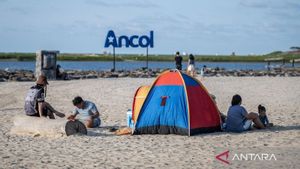JAKARTA - The Meteorology, Climatology and Geophysics Agency (BMKG) said that the number of tropical cyclones that occurred during October 2020 in the West Pacific Ocean and South China Sea was above normal.
BMKG Deputy for Climatology Herizal said that during October there had been 7 cyclones in the West Pacific Ocean and South China Sea.
"Meanwhile, the climatological average of tropical cyclone events for October is 3-4 events," he said as quoted by Antara, Tuesday, November 3.
He explained that currently Goni Tropical Cyclone which has developed into a strong category 5 tropical cyclone is being watched out for because it can trigger high waves of water, heavy rain and strong winds in a number of areas in Indonesia.
The Goni Tropical Cyclone is formed in the West Pacific Ocean and its route is predicted to lead to the South China Sea until the next few days after passing through the Philippines.
Goni's Tropical Cyclone is the third tropical cyclone that has a significant impact on a number of Southeast Asian countries around the South China Sea after the Saudel and Molave Tropical Cyclones.
A number of studies suggest that there is a relationship between the number of tropical cyclones in the West Pacific Ocean and South China Sea and the ongoing La Nina event.
Cyclone formation (cyclogenesis) was found to have a greater chance of approaching winter in the northern hemisphere after the onset of La Nina, while more cyclone formation in summer during the onset of El Nino.
Then, he continued, the study also explained that in La Nina, the South China Sea tends to have more tropical cyclones in September and October. Meanwhile, in other areas of the Western Pacific Ocean, tropical cyclone activity tends to decrease from August to November.
However, in that regard, according to him, there are still differences of opinion among climate scientists, where some of them state that El Nino conditions cause the intensity of tropical cyclones to be stronger and have a longer duration.
Recent studies reveal that if the La Nina event occurs and the sea surface temperature conditions around the Indo-Pacific warm pool indicate the persistence of being cooler than the surrounding area, the likelihood of a tropical cyclone will exceed normal conditions.
"It needs to be understood by the public that La Nina is not a type of tropical storm, it is not a center of low pressure and a whirlwind that causes extreme rainfall and wind speed," he said.
La Nina is a condition of deviation (anomaly) in the sea surface temperature of the central and eastern tropical Pacific Ocean which is cooler than normal, and is followed by a strengthening of the east trade wind flow.
La Nina occurs on a time scale of several months to years, and affects global weather or climate in the form of wetter or drier, warmer or cooler conditions, and other weather dynamics that vary from region to region in the world.
Meanwhile, tropical storms or cyclones are extreme phenomena of weather disturbances on a scale of hundreds of kilometers which have regional impacts, either directly or indirectly, and last for several days.
The public is advised to remain calm about untrue news related to tropical storms which are considered the same as the La Nina phenomenon.
However, the community is expected to remain vigilant and anticipate the possible impacts of La Nina, namely the threat of floods, flash floods, and landslides due to extreme rainfall.
"The community can participate by improving waterways, increasing water storage capacity and harvesting rain, and cutting excess or fragile tree branches," he said.
Then, be careful and pay attention to the strength level of billboards and pedestrian bridges, and pay more attention to the dynamic and fast weather developments. The public is advised to continue to obtain the latest information from the BMKG.
The English, Chinese, Japanese, Arabic, and French versions are automatically generated by the AI. So there may still be inaccuracies in translating, please always see Indonesian as our main language. (system supported by DigitalSiber.id)













